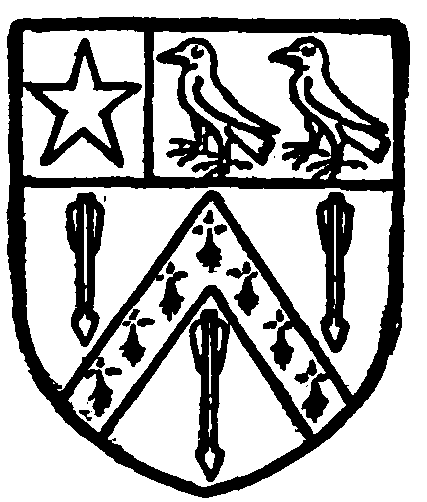Pages 48-49
A History of the County of Lancaster: Volume 8. Originally published by Victoria County History, London, 1914.
This free content was digitised by double rekeying. All rights reserved.
In this section
ALDCLIFFE
Aldeclif, Dom. Bk.; Aldecliue, 1212; Aldeclyve, 1292; Awcliff (xvi cent.) representing the current pronunciation.
Occupying rising ground on the east bank of the Lune, (fn. 1) where the river bed begins to widen into an estuary, Aldcliffe commands a good view over the river and the Little Fylde on the west. It has some lowlying marsh land in the north-west. The area is 1,016 acres, of which 27½ are salt marsh. (fn. 2) In 1901 the population numbered eighty-three. The chief road goes south from Lancaster to Stodday; minor roads and footpaths lead from it down to the riverside. The London and North Western Railway Company's branch line from Lancaster to Glasson Dock runs through the lower ground on the west side, and the Preston and Lancaster Canal touches the north-east border. The land is mostly in pasture. The soil is heavy.
Manor
In 1066 ALDCLIFFE was assessed as two plough-lands and formed part of the Halton fee of Earl Tostig. (fn. 3) Afterwards it was granted to Count Roger of Poiton, who in 1094 gave it in alms to the Abbey of St. Martin of Sees, (fn. 4) from which time it was held by Lancaster Priory (fn. 5) and then by Syon Abbey. (fn. 6) After the Suppression it was retained for a time by the Crown, (fn. 7) but in March 1557–8 it was sold, together with Bulk, to Robert Dalton of Thurnham. (fn. 8) After descending like the other Dalton estates, one portion of it went with Dorothy, the younger daughter and co-heir of Robert Dalton (who died in 1700), to the Riddells of Swinburne Castle, Northumberland, (fn. 9) while the rest, having been devoted to the maintenance of the Roman Catholic secular clergy, was confiscated by the government after an inquiry in 1716. (fn. 10)

Dalton. Azure a lion rampant gardant between eight crosslets argent.

Riddell. Argent a fesse between three garbs of rye azure.
One-fifth of the forfeited estate went to the informer, Robert Blackburn, as freehold. Richard Leigh of Newton-in-Bowland obtained a lease from the Crown for the other four-fifths, (fn. 11) and in this in 1724 he was succeeded by his son Benjamin Leigh, who acquired the other fifth from Blackburn in 1742, and bequeathed the whole estate to Robert Dawson, husband of his eldest daughter Isabel. Dying in 1769 Robert Dawson was succeeded by his only son John, who about 1800 purchased the leasehold fourfifths from the Crown, together with the manor and all customary liberties, including the right to maintain a baulk for taking salmon. (fn. 12) John Dawson died in 1804, and his only son Edward, who came of age in 1814, purchased the Riddell portion of the township in 1820. (fn. 13) He rebuilt the hall in 1817, and in 1820 inclosed 160 acres of the marsh by means of a long embankment, the merit of his work being recognized by the gold medal of the Society of Arts. (fn. 14) He died in 1876 and was succeeded by his son Mr. Edward Bousfield Dawson, the present lord of the manor and practically sole landowner. (fn. 15) Mr. Dawson was appointed Constable of Lancaster Castle in 1908. No courts have been held for the last century or more.

Dawson of Aldcliffe. Azure, between three arrows, points downwards, or, a cheveron ermine on a chief argent three daws proper, on a canton gules a mullet of the second.
There were disputes as to the boundary of the marsh (fn. 16) between the town of Lancaster and the lord of Aldcliffe, and a delimitation was made in 1610. (fn. 17)
The estate of Robert Serjeant of Aldcliffe was confiscated and sold by the Parliament in 1652. (fn. 18) William Walker, Mary Copeland and Henry her son registered estates as 'Papists' in 1717. (fn. 19)
As above stated, Aldcliffe Hall was a centre for missionary work in the times of persecution, but this ceased on its confiscation. (fn. 20) It was the residence, and apparently the property, (fn. 21) of the sisters (fn. 22) of the Thomas Dalton who was fatally wounded at Newbury in 1644. Two of them were living there unmarried thirty years later, and set up the inscription (fn. 23) :—
CATHOLICÆ
VIRGINES NOS
SVMVS: MVTARE
VEL (sic) TEMPORE
SPERNIMVS +
AÑO + 1674 DMI
The house itself thus became known as the 'Catholic Virgins.' (fn. 24) The depositions at the inquiry of 1716 showed that they left their interest in the estate to their nephew Robert Dalton of Thurnham in trust for the use of priests, of whom Peter Gooden was the first. He had a little school there for boys who might afterwards be sent to the seminaries abroad. (fn. 25)


